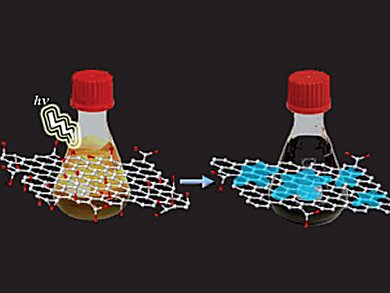Being the thinnest possible of all materials, graphene exhibits intriguing physical properties, such as high carrier mobility, high mechanical strength, high surface area, a tunable band gap, and superior thermal conductivity. These characteristics lead to a wide range of potential applications, ranging from electronic devices and reinforced composites to energy applications. An easy, sustainable, large-scale synthesis of separated graphene sheets (GSs), and preferably also their solution-phase processing, is strongly desired.
Xin-Hao Li, Max Planck Institute of Colloids and Interfaces, Potsdam, Germany, and colleagues, obtained stable aqueous dispersions of GSs by exposing graphene oxide to irradiation with light at room temperature, without using any chemical additives. The photochemical reduction method is sustainable and scalable, repairs a majority of defects in the graphene layers, and can be used to finetune surface functional groups. Interestingly, the aqueous GS dispersions are stable without any added surfactant. The existence of a water layer that is strongly bound to GS is evidenced.
As no chemical additives and no purification process are involved, the method is simple, low cost, and compatible with sustainable technical production schemes.
- A Green Chemistry of Graphene: Photochemical Reduction towards Monolayer Graphene Sheets and the Role of Water Adlayers,
Xin-Hao Li, Jie-Sheng Chen, Xinchen Wang, Manfred E. Schuster, Robert Schlögl, Markus Antonietti,
ChemSusChem 2012.
DOI: 10.1002/cssc.201100467




